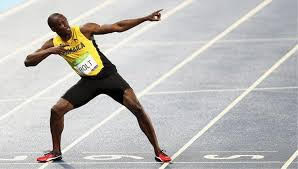When Usain Bolt exploded onto the global stage, he wasn’t just running races—he was rewriting history in real time. Known across the world as the “Fastest Man Alive,” Bolt captured not only gold medals and world records, but also the hearts of millions. His charisma, showmanship, and dominance on the track transformed sprinting into one of the most-watched events in sports. But more importantly, he changed the game forever.
Breaking the Mold: A Sprinter Like No Other
At 6 feet 5 inches tall, Bolt was considered too tall to be a top sprinter by traditional standards. Most elite 100-meter runners are shorter, relying on quick turnover and explosive starts. But Bolt proved that stride length, raw speed, and biomechanics could work together in ways no one imagined. His long legs allowed him to cover ground in fewer steps he took just 41 strides to complete the 100 meters during his record-breaking 9.58-second run in 2009, compared to the usual 44–46 taken by his competitors.
That run in Berlin wasn’t just fast. It was surreal. Every millisecond seemed to stretch as he pulled away from the field with ease, leaving behind some of the best sprinters in the world as if they were running in slow motion. No one had ever dominated sprints in such a fashion and no one has since.
Beijing 2008: The Birth of a Global Icon
Usain Bolt’s defining moment came during the 2008 Beijing Olympics, where he won gold in the 100m, 200m, and 4x100m relay all in world record times. But what truly stood out was how he did it. In the 100m final, Bolt beat the field so comfortably that he began celebrating before crossing the finish line arms spread wide, chest out, soaking in the moment. That now-iconic celebration, captured by cameras across the world, signaled a new kind of athlete one who combined dominance with joy, competitiveness with charisma.
His signature “To Di World” lightning bolt pose became a symbol of confidence and flair. Suddenly, kids from all over the world not just in Jamaica were practicing sprints and striking Bolt’s pose in backyards, school fields, and playgrounds.
Redefining the Limits of Human Speed
Before Bolt, the 100-meter world record had been improving by mere hundredths of a second. When he ran 9.69 in Beijing and then 9.58 in Berlin a year later, the leap was astronomical. Experts began questioning how it was possible and whether we had finally seen the upper limit of human speed. Bolt didn’t just run faster; he changed the conversation around what was physically possible.
Coaches and sports scientists scrambled to study his technique: his unusually high top-end speed, efficient running form, and ability to maintain acceleration longer than any sprinter before him. Training programs worldwide began evolving, influenced by what they learned from Bolt’s biomechanics.
From Trelawny to the World: A Jamaican Power Surge
Bolt’s rise also put the spotlight squarely on Jamaica, a small Caribbean island that suddenly became the center of the sprinting universe. Jamaica had always produced great athletes, but Bolt’s success ushered in a golden era. Athletes like Yohan Blake, Shelly-Ann Fraser-Pryce, and Elaine Thompson-Herah followed in his footsteps, dominating global competitions and solidifying Jamaica’s sprinting dynasty.
Bolt’s influence went beyond medals he gave hope. In a country where economic opportunities can be limited, his journey from the small town of Trelawny to global fame became a symbol of what’s possible through talent, discipline, and belief.
A New Standard for Sporting Stardom
While many athletes dominate their sport, few transcend it. Bolt did. He wasn’t just a sprinter; he became a brand, a cultural phenomenon. From Puma endorsements to animated cameos, from late-night TV appearances to global DJ sets after retirement, Bolt embraced the spotlight in a way that made track and field fun again. He wasn’t trying to be perfect he was being himself.
This authenticity made Bolt relatable. He danced, he laughed, he played—before and after obliterating his opponents. That balance of intensity and lightheartedness set a new standard for how athletes could engage with fans and the media while staying true to their roots.
Legacy: More Than Records
Usain Bolt retired in 2017 after an incredible career that included 8 Olympic gold medals and 11 World Championship titles. Though injury marred his final races, his legend was already untouchable. His records still stand, and even with a new generation of sprinters rising, no one has truly come close to matching his dominance.
But Bolt’s legacy goes beyond times and trophies. He inspired millions to dream big, to run fast, to smile in the face of pressure. He showed that greatness isn’t just about winning it’s about how you win, and how you carry that victory with grace, swagger, and humility.
Usain Bolt didn’t just change the game he became the game. He transformed the world’s view of what it means to be fast, to be a champion, and to be a true sports icon. His records may one day be broken, but his impact? That’s timeless.

